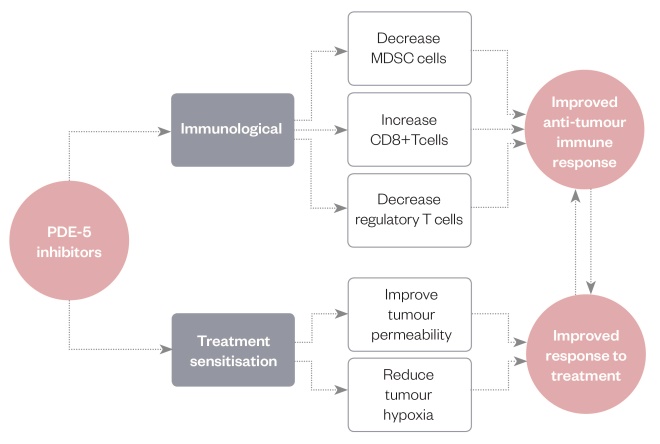
The infamous ‘little blue pill’, Viagra (sildenafil), is one of the world’s most successful products of drug repurposing — widening a drug’s use for more than one indication. Originally developed in the 1990s by Pfizer to treat hypertension and angina, it became apparent during clinical trials that sildenafil induced penile erections, and the rest, as they say, is history. Now, basic scientific data and results from clinical studies have suggested that sildenafil and other phosphodiesterase type 5 (PDE-5) inhibitors, such as tadalafil, may have multiple applications in cancer, heart failure, neurodegenerative diseases, circulatory disorders and even infectious diseases.
“In some ways, repurposing is a standard part of drug development,” says Pan Pantziarka from the Anticancer Fund, a research initiative based in Brussels. “Once [a pharmaceutical company] has a licence, they then seek to repurpose [the drug].” Pantziarka is programme director for drug repurposing and coordinator of the Repurposing Drugs in Oncology (ReDO) project (www.redo-project.org), an international collaboration between the Anticancer Fund and the not-for-profit drug development organisation GlobalCures, based in Massachusetts.
According to the US government trials registry, there are over 650 trials for PDE-5 inhibitors ongoing for an array of conditions. But with first-generation PDE-5 inhibitors off-patent since 2013, and limited interest from the pharmaceutical industry, there is no clear path to repurposing.

Source: Courtesy of Pan Pantziarka
Pan Pantziarka, from the Anticancer Fund, a research initiative based in Brussels, explains that since a lot of older drugs have been generic for decades, it is difficult for a pharmaceutical company, or even a generics company, to invest
Cancer
The challenges involved in running trials with off-patent drugs is partly why ReDo exists. “I became involved because my son had osteosarcoma, and he didn’t respond to standard treatments,” says Pantziarka. “I found that there were people who were looking at non-cancer drugs which had some evidence of activity in cancer.” Sadly, Pantziarka was not able to find a treatment for his son, who died in 2011, but he ended up moving from a job in computer science to oncology research and now focuses on commercially neglected therapeutic areas, including repurposing.
You can bypass the early stages of trials, so in theory the path should be clear to rapid adoption, should we have positive results
“Our intention is to find treatments we can get to patients quickly and repurposing really fits the bill very well,” he explains. “You can bypass the early stages of trials, so in theory the path should be clear to rapid adoption, should we have positive results.”
As part of the ReDo project, Pantziarka has built up a database of around 270 drugs with some potential to be repurposed as cancer therapies and this includes PDE-5 inhibitors. “Drugs like the PDE-5 inhibitors actually have a tremendous amount of existing evidence. Not just in vitro studies, but supporting data from extensive animal models, human data, case reports, and small clinical trials.”
Pantziarka explains that PDE-5 inhibitors have an immunological effect in cancer (see Figure). “There is quite a wide range of evidence to show that actually these drugs can take the brakes off the immune response, so they help the anti-tumour immune response get into gear,” he says.

Figure 1: PDE-5 inhibitors and cancer
Original supplied by Pan Pantziarka
Phosphodiesterase type 5 (PDE-5) inhibitors have an immunological effect in cancer, as well as a role in enhancing patients’ responses to existing chemotherapy drugs
MDSC: myeloid-derived suppressor cell
One suggestion is to use PDE-5 inhibitors in cancer patients after surgery to try to reduce cancer reoccurrences[1]
. “Because the PDE-5 inhibitors work on an immunological basis, and we think that the post-surgical reoccurrence is partly immune based, that is a really good fit,” says Pantziarka. A phase I trial at the Ottawa Hospital Research Institute in Canada is trialling tadalafil use for five days before abdominal cancer surgery until ten days after, in combination with a protective influenza vaccine, to see if this impacts on cancer reoccurrence.
PDE-5 inhibitors have really proven to be excellent drugs for repurposing in anti-cancer therapeutics
PDE-5 inhibitors also seem to have a role in enhancing patients’ responses to existing chemotherapy drugs. There are the obvious vasodilating effects that may allow more of a drug to reach its tumour targets but there is also evidence that tumour cells over-express PDE-5 in breast, liver and lung cancers, so there may be other mechanisms at play. Paul Dent’s laboratory at Virginia Commonwealth University in the United States is dedicated to developmental cancer therapeutics and is involved in several collaborations to investigate the impact of PDE-5 inhibitors and cancer drugs.
“PDE-5 inhibitors have really proven to be excellent drugs for repurposing in anti-cancer therapeutics,” says Dent. “We were able to show that Viagra enhanced the lethality of breast cancer chemotherapy doxorubicin against prostate cancer cells[2]
.”

Source: Courtesy of Paul Dent
Paul Dent, whose laboratory at Virginia Commonwealth University in the United States, is dedicated to developmental cancer therapeutics, says that PDE-5 inhibitors have proven to be excellent drugs for repurposing in anti-cancer therapeutics
Dent’s group has also looked at combining PDE-5 inhibitors with the newer cancer-fighting kinase inhibitors. “We discovered that, for example, PDE-5 inhibitors can enhance the lethality of Bayer’s sorafenib (Nexavar) and regorafenib (Stivarga) in gastrointestinal tumours (including liver, pancreatic and bowel cancer)[3]
.”
“What we observed was that Viagra particularly — as that’s what we’ve tended to work with — was very good at enhancing the ability of these drugs to activate death receptor signalling. But it was also really good at inducing a toxic form of autophagy, so a couple of things were going on,” says Dent.
Dent has also seen good results in the treatment of brain tumours. Getting cancer drugs into the brain is a problem, but PDE-5 inhibitors seem to help. “[PDE-5 inhibitors] are able to interfere with the pumps that are involved with the blood-brain barrier (BBB) and so you can also envisage using Viagra to try to further disrupt the BBB in patients with glioblastoma.” PDE-5 inhibitors also cause higher levels of nitric oxide and a greater free-radical load within cancer cells, which helps to kill them.
Dent has started a phase II study on high-grade recurrent glioma using a combination of sorafenib, repurposed seizure medicine valproic acid, and sildenafil. “We have seen some quite nice six-month progression-free survival in some of these patients,” he says.
Another important factor in PDE-5 inhibitors’ cancer fighting-properties is their ability to disrupt the effects of mutant K-RAS oncogenes. These cell signalling genes control cell proliferation, but when mutated lead to cancer, a mechanism involved in 90% of pancreatic cancers and 50% of bowel cancers.
Newer lines of evidence are saying that PDE-5 inhibitors actually having a direct effect on the heart tissues
Working with John Hancock at the University of Texas, Dent has looked at combinations of drugs that could affect this cancer-causing mutant gene. The US Food and Drug Administration-approved kinase inhibitor neratinib (Nerlynx; Puma Biotechnology) removes mutant K-RAS proteins and another cancer-causing protein, N-RAS, from the surface of cancer cells, allowing them to be degraded inside the cell, thus halting their ability to cause cell proliferation and chemotherapy resistance. “John demonstrated that Viagra, through protein kinase G (PKG), would phosphorylate the [mutant] RAS [protein] and would take it off the plasma [cell] membrane and keep it stored at an intracellular site where it couldn’t act as an oncogene.” Using a combination of neratinib and sildenafil, Dent and Hancock found there was a larger effect on mutant K-RAS. They are currently exploring the cellular mechanisms involved.
Cardiovascular disease
Emerging evidence suggests that PDE-5 inhibitors have direct cardioprotective effects. Their role in dilating arteries and improving blood flow is already well known (see Panel), with sildenafil (Revatio; Pfizer) and tadalafil (Adcirca; Eli Lilly) approved for treating pulmonary arterial hypertension.
“But newer lines of evidence are saying that they’re actually having a direct effect on the [heart] tissues,” says David Hutchings, honorary clinical lecturer in cardiovascular sciences at the University of Manchester, UK.

Source: Courtesy of David Hutchings
David Hutchings, honorary clinical lecturer in cardiovascular sciences at the University of Manchester, admits the picture for heart failure is not clear and says PDE-5 inhibitors are certainly “not a panacea”
Animal models show that PDE-5 inhibitors improve some abnormalities that occur in heart disease, which seem to be linked to the activation of PKG in cardiac cells and the vasculature — they improve contractile function in the heart[4]
.
But not all trials of PDE-5 inhibitors in cardiovascular disease have been successful. A large US trial — RELAX — looked at using PDE-5 inhibitors to treat heart failure with preserved ejection fraction or “diastolic HF”, which accounts for approximately half of heart failure cases and has a poor prognosis[5]
. The trial showed no improvement in either contractile function or in the patient’s breathlessness or hospital admission rate.
Hutchings admits the picture for heart failure is not clear and says PDE-5 inhibitors are certainly “not a panacea”. However, there does seem to be some cardioprotective effect, he says, particularly after a heart attack, when they could prevent further damage, and in heart failure with reduced ejection fraction, when the muscle of the left ventricle is not pumping normally. “But in the absence of large, randomised trials, it hasn’t been proven as such. So PDE-5 inhibitors are not routinely prescribed to protect the heart.” Hutchings believes that it is time for these trials to take place, but adds that they would be expensive and would need a large charity or public body to sponsor them.
Neurological disorders
The ability of PDE-5 inhibitors to open up the vasculature, as well as some being able to pass through the BBB, suggests they are good candidates for treating neurological diseases. Research has shown that sildenafil is successful in inhibiting neuro-inflammation and, in aged mouse models, lowering amyloid levels, the peptide plaques that are thought to clog the brain in Alzheimer’s disease[6]
. Tadalafil was able to penetrate the BBB more effectively in mice than sildenafil but there have been no clinical trials for repurposing either drug in Alzheimer’s disease[7]
.
However, there has been some work on the use of PDE-5 inhibitors to treat vascular cognitive impairment, a form of dementia that receives less attention. “Often, it’s not quite dementia it’s a milder, earlier stage cognitive impairment,” says Atticus Hainsworth, a neuroscientist from the Neurosciences Research Centre at St George’s University of London.
The underlying problem is not enough blood flow to deep brain areas. “We have a huge brain and the deep bits rely on very thin arteries, about as thin as your eyelash, to carry blood. If they become stiff or narrow, or in some way not quite functional, the inner brain regions won’t get quite enough blood. It’s not that they’ll be blocked, they’ll perhaps get 50% to 70% of what they need,” explains Hainsworth. The theory is that a PDE-5 inhibitor may improve blood flow.
Hainsworth, funded by the UK Alzheimer’s Society and the New York-based Alzheimer’s Drug Discovery Foundation, has just completed a phase II trial of tadalafil in 54 participants with brain vascular disease to see if it improves cognitive function[8]
. He is currently analysing the results.
A Boston University and University of Pennsylvania clinical trial is also looking at PDE-5 inhibitors, this time for treating traumatic microvascular injury in American football players[9]
. The researchers are giving players with a history of mild traumatic brain injury a five-week course of sildenafil and hope to increase cerebrovascular reactivity — the capacity for cerebral blood vessels to dilate, which is a factor in assessing brain disorders and is often diminished by traumatic brain injuries.
Infectious diseases and other possible uses
The potential for repurposing of PDE-5 inhibitors seems immense. Dent says there are even indications that PDE-5 inhibitors could have antiviral and antibiotic properties[10],[11]
. In combination with other drugs, they may be able to tackle hard-to-kill viruses, he says: “I mean, viruses like drug-resistant HIV, ebola, drug-resistant influenza, mumps, measles and rubella.”
In addition, clinical trials or basic research have found PDE-5 inhibitors have a therapeutic effect in the recovery of peripheral neuropathy in mice with diabetes[12]
, for treating age-related macular degeneration[13]
, for male urogenital disease[14]
and for cystic fibrosis[15]
.
I think the fact that sildenafil has been so widely described and the uptake has been so big, has given us this opportunity to look at it from different angles
There are also a few studies suggesting PDE-5 inhibitors could be helpful in in vitro fertilisation treatment. Endometrial thickness is a strong predictor of implantation and ongoing pregnancy, and sufficient thickness is dependent on the uterine blood flow — something PDE-5 inhibitors could increase[16]
.
This enormous list to some degree reflects PDE-5 inhibitors’ ability to dilate the vasculature, and the therapeutic possibilities this offers. But it also reflects their multi-target properties. “I like to think of these as multi-targeted agents in contrast to the closely targeted agents, which are the more common thing in drug development now,” says Pantziarka.
“[Sildenafil is] a pretty unique drug,” adds Hutchings. “I think the fact that it’s been so widely described and the uptake has been so big, has given us this opportunity to look at it from different angles.”
Repurposing problems
Whether all of this research will culminate in new licensed indications remains to be seen. Although repurposing promises cheap, effective drugs, there are problems associated with the process.
We have a situation where, yes the drugs are cheap, yes they may be effective, but there are financial disincentives to invest in the necessary research
Dent says that when trying to combine new, expensive drugs with an older product, getting large pharmaceutical companies on board can be tough. “With small pharma, we’ve had a lot of success getting drugs,” but, he adds, “we deliberately think before we’ve even done an experiment: ‘How could we do this experiment more cheaply so that the cancer centre only has to buy one expensive drug and not two?’.”
Pantziarka explains that, since a lot of older drugs have been generic for decades, and in some cases there are dozens of manufacturers, it is difficult for a pharmaceutical company, or even a generics company, to invest. “We have a situation where, yes the drugs are cheap, yes they may be effective, but there are financial disincentives to invest in the necessary research.”
Public funding is not easy to access either. For example, Pantziarka says that EU Horizon 2020, a research and innovation programme with nearly €80bn of funding available between 2014 and 2020, requires applicants to show they own the intellectual property — it is designed for innovations that provide an economic outcome, rather than value to patients and society. “We are a bit disappointed that there isn’t more of an appetite for funding this kind of work,” he admits.
It is also difficult for researchers to get a drug licensed for a new indication. “The state of play at the moment, in Europe at least, is if you want to licence a drug for a new medical indication you need to be a manufacturer, you need to have the marketing authorisation,” says Pantziarka. “So a not-for-profit organisation can’t turn up at the European Medicines Agency or the Medicines and Healthcare products Regulatory Agency and say, look, we have got evidence that sildenafil is an anti-cancer drug.”
“Repurposing [PDE-5 inhibitors] ticks a lot of boxes: they are cheap drugs, they tend to have low toxicity and we know what dosages to use. So there are a lot of positives,” he says. “But all those positives count for zero if you don’t have the efficacy evidence.”
This evidence is mounting, though, and it is likely that at some time in the future, we may all find ourselves taking these versatile ‘little blue pills’.
“They are probably not, as a single agent, going to be some wonder drug, but as a modulator of therapeutic response, they are going to be fantastic,” says Dent.
Panel 1: Mechanism of action
Phosphodiesterase type 5 (PDE-5) is an enzyme that catalyses the hydrolytic degradation of cyclic guanosine monophosphate (cGMP), an essential intracellular messenger that modulates a diverse number of biological processes in cells. PDE-5 inhibitors are able to reduce the effect of the PDE-5 enzyme and prevent cGMP hydrolysis.
There are 11 families of PDEs encoded by 21 genes. PDE-5 is widely expressed in tissues, such as the brain, lung, kidney, urinary bladder, smooth muscle and platelets, and this gives it a wide therapeutic scope. Other PDEs have also been investigated but, to date, PDE-5 inhibition seems to be the most successful therapeutic strategy.
In erectile dysfunction, PDE-5 inhibitors promote the relaxation of penile smooth muscle by slowing down cGMP degradation, allowing the natural nitric oxide (NO)-mediated pathway — responsible for the muscle relaxation process that causes an erection. cGMP promotes NO production by activating protein kinase G (PKG), which phosphorylates a number of biologically important targets. The muscle-relaxing properties of PDE-5 inhibitors also cause vasodilation.
- This article was corrected on 14 November 2018 to add citations for research indicating that PDE-5 inhibitors could have antiviral and antibiotic properties.
References
[1] Tai LH, Alkayyal AA, Leslie AL et al. Phosphodiesterase-5 inhibition reduces postoperative metastatic disease by targeting surgery-induced myeloid derived suppressor cell-dependent inhibition of natural killer cell cytotoxicity. OncoImmunology 2018;7(6):e1431082. doi: 10.1080/2162402X.2018.1431082
[2] Das A, Durrant D, Mitchell C et al. Sildenafil (Viagra) sensitizes prostate cancer cells to doxorubicin-mediated apoptosis through CD95. Oncotarget 2016;7(4):4399–4413. doi: 10.18632/oncotarget.6749
[3] Booth L, Roberts JL, Poklepovic A & Dent P. PDE5 inhibitors enhance the lethality of [pemetrexed + sorafenib]. Oncotarget 2017;8(8):13464–13475. doi: 10.18632/oncotarget.14562
[4] Hutchings DC, Anderson SG, Caldwell JL & Trafford AW. Phosphodiesterase-5 inhibitors and the heart: compound cardioprotection? Heart 2018;104(15):1244–1250. doi: 10.1136/heartjnl-2017-312865
[5] Redfield M, Borlaug B, Lewis G et al. Phosphodiesterase-5 Inhibition to improve clinical status and exercise capacity in diastolic heart failure: the RELAX trial rationale and design. Circ Heart Fail 2012;5(5):653–659. doi: 10.1161/CIRCHEARTFAILURE.112.969071
[6] Zhang J, Guo J, Zhao X, Chen Z et al. Phosphodiesterase-5 inhibitor sildenafil prevents neuroinflammation, lowers beta-amyloid levels and improves cognitive performance in app/ps1 transgenic mice. Behav Brain Res 2013;250:230–237. doi: 10.1016/j.bbr.2013.05.017
[7] Garcia-Barroso C, Ricobaraza A, Pascual-Lucas M et al. Tadalafil crosses the blood-brain barrier and reverses cognitive dysfunction in a mouse model of AD. Neuropharmacology 2013;64:114–123. doi: 10.1016/j.neuropharm.2012.06.052
[8] Pauls MMH, Clarke N, Trippier S et al. Perfusion by arterial spin labelling following single dose tadalafil in small vessel disease (PASTIS): study protocol for a randomised controlled trial. Trials 2017;18:229. doi: 10.1186/s13063-017-1973-9
[9] University of Pennsylvania. Cerebrovascular reactivity in American football players. Clinical Trials.gov Identifier: NCT03417492. Available at: https://clinicaltrials.gov/ct2/show/NCT03417492 (accessed November 2018).
[10] Roberts JL, Tavallai M, Nourbakhsh A et al. GRP78/Dna K is a target for Nexavar/Stivarga/Votrient in the treatment of human malignancies, viral infections and bacterial diseases. J Cell Physiol 2015;230(10):2552–2578. doi: 10.1002/jcp.25014
[11] Booth L, Roberts JL, Cash DR et al. GRP78/BiP/HSPA5/Dna K is a universal therapeutic target for human disease. J Cell Physiol 2015;230(7):1661–1676. doi: 10.1002/jcp.24919
[12] Wang L, Chopp M & Zhang ZG. PDE5 inhibitors promote recovery of peripheral neuropathy in diabetic mice. Neural Regen Res 2017;12(2):218–219. doi: 10.4103/1673-5374.200804
[13] Coleman DJ, Lee W, Chang S et al. Treatment of macular degeneration with sildenafil: results of a two-year trial. Ophthalmologica 2018;240:45–54. doi: 10.1159/000486105
[14] Andersson KE. PDE5 inhibitors — pharmacology and clinical applications 20 years after sildenafil discovery. Br J Pharmacol 2018;175(13):2554–2565. doi: 10.1111/bph.14205
[15] Noel S, Dhooghe B & Teresinha L. PDE5 inhibitors as potential tools in the treatment of cystic fibrosis. Front Pharmacol 2012;3:167. doi: 10.3389/fphar.2012.00167
[16] Benni JM & Patil AP. An overview on sildenafil and female infertility. Indian J Pharmacol 2016;9(2):131–136. doi: 10.4103/2349-5006.191247

